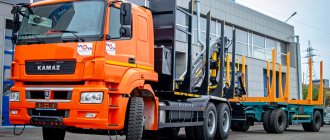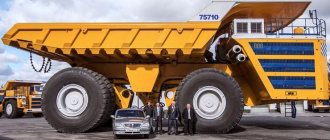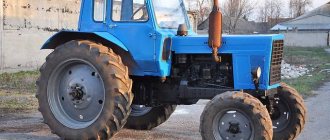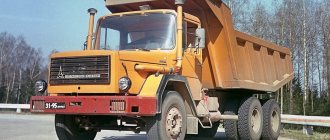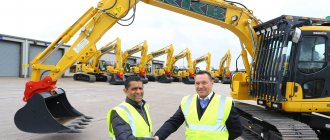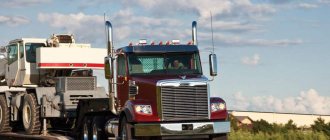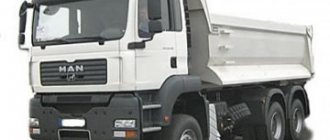Article published 07/30/2014 10:47 Last edited 11/03/2015 18:23
| Full title: | Minsk Wheel Tractor Plant |
| Other names: | Volat |
| Existence: | 1954 - present day |
| Location: | (USSR) Belarus, Minsk |
| CEO: | Vitaly Vovk. |
| Products: | Heavy-duty wheeled tractors |
| The lineup: | Information on models is temporarily unavailable |
Having recovered from the Great Patriotic War, the Soviet Union began to develop at a rapid pace. New enterprises were built in all union republics.
To produce heavy equipment, a specialized design bureau No. 1 was opened on the basis of the Minsk Automobile Plant. The date of creation of the design bureau is considered to be 07/23/1954.
MAZ-535
Experienced and hardworking designers worked in the design bureau. It took the close-knit team only two years to construct and “bring into production” an experienced tractor – the MAZ-535.
Minsk Wheel Tractor Plant
I started working with the release of this particular model.
Chassis production
In mechanical assembly shop No. 3, from the beginning of 1959, plant workers began manufacturing individual parts and components of tractors. The general assembly of finished products was carried out in the same workshop.
The “firstborn” of the MAZ-537 series was ready by the beginning of spring of the same year. However, mass production was never established. The reason was the decision of the country's top leadership made in the summer of 1959. The plant was given a new task: chassis development.
All developments, including drawings and technical documentation, were sent to a number of other factories. In particular, they were received by enterprises in Yaroslavl, Mogilev and Kurgan.
From now on, MZKT carried out a strategically important mission - manufacturing the chassis of a ballistic missile launcher. The missile system was called "Temp-S". The chassis with the MAZ 543 index was ready in 1962.
The scale of the state order was so large that by the end of the sixties production capacity had to be increased. During the period from 71 to 79, five buildings were fully built and put into operation. Their total usable area was about one and a half hundred square kilometers. The second mechanical assembly building is located on most of this area (108 km2).
It should be noted that the equipment of the erected production workshops and sites was the most advanced. With this approach to business, even greater returns were expected from MZKT.
Advantages and disadvantages
Order special equipment on our website: Dump trucks and tonars in Russia
The undeniable advantages of the MZKT 65151 are its simplicity of design and unprecedented reliability, trouble-free operation, as well as the availability of all necessary spare parts and assemblies, which ensure good maintainability of the model.
We are also pleased with the thoughtfulness of the body design and its excellent quality. The tailgate locks are designed in such a way that clogging is minimal during unloading. Ladders for platform maintenance are installed where they belong, so there is no inconvenience when carrying out all necessary routine work.
However, like everything in this world, Volat also has certain disadvantages:
- Inadequate quality of materials used to manufacture the cabin and body, hence their susceptibility to corrosion.
- The level of cabin comfort leaves much to be desired.
- As the car turns into a turn at an impressive speed, the load on the engine increases and it loses speed.
- When driving through quarries in a loaded state, the machine may become buried under the drive wheels.
- When overloaded, the stability of the dump truck decreases.
PSKT
PSKT is an abbreviation for the Production of Special Wheeled Tractors created in 1975. Much attention was paid to production, so it developed at a rapid pace.
The reconstruction project was prepared in 1978. In accordance with the project, another building was built over several years (1979-1986).
Building No. 3 is located on an area of approximately 45 km2. In addition, other production areas appeared. The total number of workshops was four dozen.
Fulfilling government orders, MZKT continued to assemble tractors for several missile systems, including Elbrus and Temp-S. Missile systems with the formidable name “Smerch” were moved by factory tractors. The Ministry of Defense of the Soviet Union ordered equipment here for transporting air and ground defense missiles, such as Bereg, S-300, as well as other complexes.
About the Minsk Wheel Tractor Plant
The dump truck is the brainchild of the Minsk Wheel Tractor Plant, an enterprise specializing in the development and manufacture of special vehicles for transporting heavy loads both on public roads and in off-road conditions.
These tractors are produced under the Volat brand, which translated into Russian means “Bogatyr”. The plant's products are mass-produced, but standard practice is to manufacture special equipment according to individual customer orders - in such cases, the number of copies varies from one to several hundred pieces.
Important
In fact, Volat technology is a legacy of large missile-carrying tractors produced during the Soviet Union. Their indisputable advantage is the ability to work in the most difficult operating conditions, literally amazing with their endurance and excellent performance properties.
Speaking about the manufacturer in more detail, first of all, we should mention its slogan - “Technology that knows no barriers!” Considering the driving performance of the vehicles developed at this JSC, this motto was not chosen by chance. Today the company employs more than 5 thousand people; its structure includes 10 production workshops, as well as 3 workshops performing auxiliary functions.
The plant is state-owned, its history dates back to the 50s of the last century, from the founding of the Special Design Bureau, which was engaged in the creation of multi-axle off-road trucks, developed primarily to meet the needs of the Soviet army at that time.
On the basis of this enterprise, heavy trucks for transporting tanks and missile systems, as well as mobile airfield fire departments, were developed. After the collapse of the Union, the plant formed the basis of MZKT OJSC, its production facilities were repurposed for the production of trucks intended for civilian use. Each of them is based on a military chassis, so it is not surprising that such equipment has virtually no wear and tear.
As of today, chassis for special equipment, tractors, including multi-axle ones, dump trucks and other vehicles with a wheel arrangement of 4 by 4, 6 by 4, 6 by 6, 8 by 4, 8 by 8, etc. come off the assembly line of the enterprise. d. The longest and largest truck is made according to a 16 by 16 layout.
In addition to classic “large-caliber” trucks, the company supplies the market with chassis on which equipment for use in oil fields is subsequently mounted, cranes with a lifting capacity of up to 160 tons, ballast tractors, etc.
The plant's developments continue to be actively used in military equipment and modern weapons. Most products are exported to Russia, but in the last few years, connections have begun to appear in other areas of the market, in particular, deliveries to China, the UAE, Turkey and Egypt have become more frequent.
MAZ-543
The chassis of the MAZ-543 model is of greatest interest. It was produced in the seventies and eighties. A distinctive characteristic of this product was its exceptionally high load capacity. At the same time, cross-country ability remained at a high level.
MAZ-543
Thanks to the mentioned qualities, the chassis was first mass-produced, and after some time its modifications appeared, intended for specific industries: transport and construction. Even road trains were assembled on the basis of the MAZ-543.
Technical characteristics, modifications
The vehicle that became the topic of our conversation first appeared on the market in 2001, it was released to meet the growing demand at that time for massive four-axle trucks that could travel on general highways.
Engine
Describing the technical characteristics of MZKT 65151, let's start with the power plant. Initially, diesel engines produced by the Tutaevsky Motor Plant were installed on this model. Their power was 410 hp. A little later, it was decided to use YaMZ-238D power plants with 330 “horses” as an alternative, but it soon became clear that their power was not enough for such a bulky equipment.
They were abandoned, replacing the mentioned engines with more durable versions YaMZ-7511.10 and YaMZ-7512.10. We are talking about 8-cylinder 4-stroke V-shaped units with a volume of 14.8 liters and a power of 360 hp. Both engines comply with Euro-2 requirements and are equipped with a liquid cooling system and turbocharging function.
The rotation speed is regulated mechanically, and the regulator was developed taking into account the characteristics of heavy special-purpose cargo equipment.
According to the manufacturer, the engine life is sufficient for 800 thousand kilometers. As for fuel consumption, it is 45 liters per 100 kilometers, the maximum speed is limited to 85 km/h.
Transmission and chassis
The car has a single-disc clutch, the transmission is MZKT’s own development and is a 9-speed manual with synchronizer for all gears except 1st and reverse. A pneumatic cylinder and a combined lubrication system are responsible for switching in downshifts. Power is taken off to the hydraulic pump from the rear end of the crankcase from a shaft connected to the intermediate shaft of the transmission.
The drive axles are also the manufacturer's own design. The first driving solid axle includes a gearbox, a locked differential (inter-wheel), as well as 2 planetary wheel gears. The through drive axle includes a gearbox and a center differential lock, as well as a power steering pump.
Shoe brakes are pneumatically driven; each wheel is equipped with them. In addition to the dual-circuit main system, there are spare, parking and auxiliary brakes that can stop the vehicle in a critical situation.
Frame and body
As mentioned above, the dump truck is based on a high-strength spar-type frame structure, which is classic for the equipment of this manufacturer, providing the vehicle with maximum reliability and endurance in any operating conditions. The model is based on the MZKT-692371, its wheel arrangement is made according to the 8 by 4 scheme.
The nominal capacity of the body is 20 cubic meters, but in fact it holds 38 cubic meters of bulk materials. Thanks to the presence of folding sides and a special installation for lifting the body, the process of unloading the vehicle is greatly simplified.
Cabin
The Volat dump truck is equipped with a 2-seater cab from the MAZ-5551, which is installed on a 4-point spring suspension with hydraulic shock absorbers for maximum operator comfort. Optionally, it is possible to install additional air suspension, but this is discussed on an individual basis.
In the basic version, the driver's seat is primitive, it is installed on only one shock absorber, so the smoothness of the ride leaves much to be desired. To ensure the proper level of comfort, you can equip the seat with air suspension, also adding an elastic element, but this is permissible in more advanced modifications. The steering column is adjustable in two positions – height and tilt.
Gear shifting is carried out using a special mechanism equipped with a pneumatic cylinder; in addition to the fuel pedal, a latch is used that fixes the required position in the mode of warming up the power unit and inflating the wheels. The rear view mirrors are equipped with a heating function. The condition of the filters (oil and air) is controlled automatically.
By default, the cabin is equipped with a primitive ventilation and heating system; an optional air conditioner can be installed. The ease of access to the cabin raises some complaints, since the first step is located quite high.
MZKT in the 80s
In the eighties of the last century, the slogan “Virgin Land” was proclaimed. Under this slogan, certain complexes were developed. So, from 1984 to 1987, unique transporters were produced. A Design and Experimental Base (KEB) was created for them.
Design developments “took on flesh” in specialized production workshops. This production was built in 1985 and occupied an area exceeding 20 km2.
In addition to transporters, under the auspices of the “Virgin” program, they assembled chassis for vehicles of the “Courier” and “Speed” brands.
Independence of MZKT
Until 02/07/1991, MKZT was part of the BelavtoMAZ Production Association. After the general director of the production association issued the corresponding order, the Minsk Wheel Tractor Plant gained independence.
MZKT consisted of separate independent structural units. First of all, this is the production of Special Wheeled Tractors. In addition, OGN, ETs-2 and UGK-2 were large branches.
The new program, developed by the plant management in 1992, included three areas of work. The first is the production of special vehicles, the second is the production of road trains and the third is the assembly of chassis for special vehicles. It was planned to carry out work not only for the needs of Belarus, but also for other CIS member countries.
MZKT products of the 90s
By the middle of the last decade of the last century, MZKT mastered the production of a large number of special automotive equipment. The list of manufactured products, in particular, includes road trains, special equipment, dump trucks, flatbed vehicles, trailers, powerful chassis and much more.
The capabilities of the enterprise were so great that they made it possible to assemble vehicles in a wide range of carrying capacity. The minimum was 12, and the maximum was 220 tons! At the same time, the spread in engine power was also surprising. If the engine is 165 hp. belonged to the standard type, then the figure is 1500 hp. Impressive!
Another characteristic of MZKT vehicles is the wheel arrangement. Depending on the load capacity and cross-country ability, it varied from 4 by 4 or 4 by 6 to 8 by 8, 10 by 10 and a maximum of 12 by 12.
Descendant of the rocket carrier MZKT-65151 “Volat” dump truck
V. Valdanov, photo by D. Nesterov
The products of the Minsk Wheel Tractor Plant (MZKT) are already familiar to our readers. We published reports in the magazine about test drives and instrumental tests of these unique Belarusian trucks. We are testing the MZKT-65151 “Volat” dump truck, which translated from Belarusian means “Bogatyr”. By the way, the name of the Minsk truck is not far from the truth.
Thirteen tons per axle - this figure for road carriers is the same as “the devil’s dozen” for the common man. However, this figure is also a stumbling block for designers of car factories in post-Soviet countries, since this load limit applies on CIS roads.
Using the MZKT-65151 car as an example, this means that when driving on public roads, as well as on the streets of cities and towns of the Russian Federation and its closest neighboring countries, the total load on the rear bogie should not exceed 26 tons. Taking into account the load on the first and the second axle, the total weight of the vehicle is 41 tons. Minus the curb weight of the vehicle, which is about 16 tons, the vehicle’s load capacity is 25 tons.
Increasing the payload weight of the cargo being transported is a reliable way to increase trucking productivity and improve fuel efficiency per unit weight. The most effective way in this case is to use a trailer (up to 30% reduction in fuel consumption), the towing of which, by the way, is not structurally provided for by the MZKT-65151 vehicle. Thus, the only option for increasing the load capacity for the designers of the Minsk Wheel Tractor Plant was the use of an additional axle, although this is associated with an increase in movement resistance and fuel consumption, a more complex design and an increase in curb weight.
But, speaking about the conditions for limiting the axle load, the manufacturer is silent about the vehicle’s capabilities in terms of the load capacity allowed by the structural units, since it can be increased by increasing the permissible load on the axle. Alternative: operating the vehicle in conditions that are not subject to restrictions (quarries, technological roads at construction sites, and finally, during the construction of those same public roads with load restrictions).
The MZKT-65151 vehicle is a dump truck designed for transporting bulk cargo. Its gigantic appearance, rather high engine power and the volume of the cargo platform (20 m3) clearly do not correlate with the declared load capacity of 25 tons. Based on the average density of bulk building materials of the order of 1.9 t/m3, it turns out that its load capacity is 38 tons.
Despite the three-meter height of the sides of the dump truck, we load the body to the top edge, making full use of its volume. We weigh the car and get 52.5 tons. Minus the curb weight, we get the mass of sand 36.5 tons, which coincides with the initial assumption. It was necessary to partially unload the body to obtain a total vehicle weight of 41 tons, while the body turned out to be 2/3 full of volume. It is difficult to imagine such an option in operation and we can only rely on the reliability of the platform lifting hydraulic system (hydraulic valves are set to a limit of 35 tons) and tires with a higher load-bearing capacity index.
But if the consumer wants to insure against overloads, he can order a platform of smaller volumes, since the plant has other options for dump bodies - 16.5 m3 and 11.5 m3. The platforms can be equipped with a hydraulic tailgate lock, and to simplify the design and unload the platform, a bucket-type option without a tailgate is used.
During testing, we noted the following features: when entering a turn, the load on the engine increases significantly until there is a noticeable decrease in speed, and when exiting a turn, the car accelerates. But this applies to sharp turns at high speed. With the right choice, driving is more confident, but only on paved roads. And when driving in a quarry, even in a smooth turn, due to the large mass, the car’s steered wheels burrow into the sand. In this case, locking the center and wheel differentials that the car is equipped with is simply necessary.
MZKT-65151 has a two-seat MAZ-5551 cab, a four-point cab suspension, spring with hydraulic shock absorbers. An air cab suspension may be considered as an option, and a driver's seat with an air spring is included as standard. But even the simplest version of seats with a plate torsion bar and shock absorber - such as on the car under test - provides only satisfactory softness in the driver's seat. It should be noted that special attention was paid to the driver’s working conditions: the steering wheel is adjustable in height and tilt; electrically heated rear view mirrors; gear shift mechanism, equipped with a power pneumatic cylinder; the fuel pedal is equipped with a latch that fixes its position in the engine warm-up and tire inflation modes; as well as a system for monitoring air and oil filters for clogging. The car cabin in the southern version is equipped with Webasto air conditioning. The only difficulty is the height of the first step when boarding the cabin. An additional flexible step on two sections of the cable, like on the URAL-532301, would help to easily cope with this problem.
All modifications of the MZKT-65151 vehicle are equipped with the YaMZ-7511.10 engine - the most powerful of the eight-cylinder YaMZ engines that meet Euro 2 environmental standards.
The tested car is equipped with an engine with block cylinder heads, since the Yaroslavl engine of the “75th” series is based on the development of Tutaev engine builders. The gas joint between the cylinder head, the block itself and the liner is sealed with a single metal gasket with inserted rubber elements that seal the oil, water and rod passages. The engine is equipped with 19 sealing elements of five types. The YaMZ-7511.10 engine is equipped with individual cylinder heads. The gas joint on them is sealed with a metal gasket, and the holes for the passage of rods, oil and coolant are sealed with a single rubber gasket. Individual metal gaskets, which are available in four thicknesses, are assembled to achieve optimal piston clearance in each cylinder. The engine can also be equipped with pistons with a central combustion chamber and modified recesses for the valves. All these differences do not affect the main performance of the engine, the maximum torque of which is 1715 Nm at 1100...1300 rpm and power of 400 hp. at 1900 min–1. The fuel system is equipped with a Separ coarse filter with fuel heating.
The MZKT-65151 gearbox of our own production is a 2-range, 9-speed with synchronized engagement of all gears, except first and reverse. Switching ranges in downshifts is done using a power pneumatic cylinder. The gearbox lubrication system is combined - splashing and under pressure created by a built-in gear pump.
Power is taken to the platform lift hydraulic pump from the rear end of the reduction gear housing from a special shaft connected to the intermediate shaft of the gearbox.
The drive axles are also branded. The dead-end drive axle consists of a gearbox with a bevel gear, a lockable cross-axle differential, and two planetary wheel gears. The straight drive axle is distinguished by a gearbox with a spur gear and a lockable center differential; it also has a backup power steering pump. The drive of the main pump is standard from the engine. Steering mechanism of the "screw-ball nut" type with built-in distributor.
During testing, we had to replace the wheel because two bolts were caught at once. We were lucky that it was not from the steered axles, because on the road we were unable to unscrew the fastening nuts with a standard wrench, and we were forced to slowly get to the garage. And only armed with a wrench made from a KAMAZ torsion bar, we were able to quite easily unscrew and tighten the wheel nuts.
By the way, we assessed the vehicle's load on the road by how the M18 bolt was pressed into the tire tread. The device for raising and securing the spare wheel is easy to work with when two people are busy; one cannot reach the wheel and the winch handle at the same time.
The car's fuel consumption was frankly disappointing, although its values could be preliminarily judged by the extremely low value of the run-out distance from 50 km/h. For a car with a gross weight of 41 tons 935 m is a very small value. This can partly be justified by the fact that the car has not been run-in, but the main reason lies in the quality of the rubber. We should not forget that the MZKT-65151 category vehicle with the “G” index is designed for difficult driving conditions, where the very fact of cargo delivery is a priority. And the main associations that arise when we mention the MZKT-65151 dump truck will always be sand and a quarry. Nevertheless, I would like to note the simplicity of the design of the Minsk dump truck. After all, at one time MZKT was a secret department within the MAZ Production Association, which was engaged in the design, development and production of heavy multi-axle vehicles for transporting missile technology, including ballistic ones. What is the most important thing for army equipment? Simplicity of design and reliability. So this is the most important advantage of the MZKT-65151 dump truck.
The editors thank the official distributor of UE "MZKT" Group for the provided car.
Technical characteristics of MZKT-65151 (manufacturer data)
| Total weight, kg | 41 000 |
| Load capacity, kg | 25 000 |
| Engine | YaMZ-7511.10 |
| Working volume, l | 14,86 |
| Maximum power, kW | 294.0 at 1900 min–1 |
| Maximum torque, Nm | 1715.0 at 1200 min–1 |
| Fuel | diesel |
| Gearbox type, number of gears | MZKT-65151 mechanical, 9 |
| Top gear ratio | 0,795 |
| Final drive ratio | 6,59 |
| Tire size | 12.00 R20 |
Test results MZKT-65151
| Vehicle weight, kg | 16 000 | 41 000 |
| Run-out distance, m, from a speed of 50 km/h | 790 | 935 |
| Fuel consumption l/100 km, at given speeds, km/h: | ||
| 24,5 | 36,2 |
| 27,1 | 39,9 |
| 31,2 | 45,0 |
| 37,0 | 52,0 |
| 43,9 | 60,2 |
| 46,2 | 60,8 |
| Consumption in datum mode, l/100 km (at average speed, km/h) | 45,4 (37,0) | 78,8 (31,8) |
| Maximum speed, km/h | 82,5 | 80,6 |
Atmospheric conditions during testing
| Temperature, °C | 21 |
| Wind speed, m/s | 1…3 |
| Pressure, GPa | 995 |
| Relative humidity, % | 45 |
"Volat"
The new generation equipment produced by MZKT began to be called “Volat”. Under this brand, Belarusian equipment began to be exported abroad. Having won 2 tenders, the plant began cooperation with the UAE and Turkey. Road trains capable of transporting heavy tracked vehicles were supplied to these countries.
Volat
Already in our century, the Minsk Wheel Tractor Plant received ISO-9001 and ISO-2001 certificates, which confirmed the highest quality of management and compliance with international standards.
Dump truck device
The design of the Volat MZKT is based on a durable spar frame with cross members attached to the side members with bolts. This design option was not chosen by chance: firstly, it is classic for the products of this manufacturer, and secondly, it is characterized by increased strength, which is critically important for machines of such a carrying capacity.
The front has a dependent spring suspension with telescopic shock absorbers, and the rear has a spring-balancer suspension. The first rear axle is equipped with a through-type central gearbox; two additional locking differentials are used (center and cross-axle).
The second rear axle is also equipped with a locking differential, in this case it is cross-axle. Thanks to this design, which is thoughtful and carefully worked out, the MZKT dump truck is capable of transporting heavy loads.

